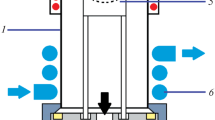Abstract
The combination of laser ablation and inductively coupled plasma mass spectrometry (LA-ICP-MS) offers a powerful tool for directly analyzing solid samples. However, LA-ICP-MS has a limitation in quantitative analyses owing to a requirement for matrix-matched standard materials. In this study, we have developed a sample preparation method that facilitates quantitative analyses by LA-ICP-MS. The sample powder is dispersed in a liquid resin and film-like samples are prepared from the resulting paste by a screen-printing technique. The sample includes the analyte spiked with internal standards and is prepared by mixing standard solutions in the sample paste. Because all reagents except for the sample powder are liquids, homogeneous samples can be easily obtained. The internal standard and concentration of the spiked analyte can be tailored for each sample, which is a requirement for accurate quantitative analyses. The amount of sample and concentration of the spiked analyte are controlled against an internal standard, enabling internal standardization without the need to have an element of known concentration in the sample. The accuracy of this method was evaluated by analyzing impurity elements in TiO2 powder; however, it is expected that other materials could also be analyzed. The versatility and flexibility of this method suggest great potential for quantitative analyses by LA-ICP-MS, for which reliable matrix-matched standard materials are required.
Graphical abstract





Similar content being viewed by others
Data availability
All data generated or analyzed during this study are included in this published article.
References
A.L. Gray, Analyst 110, 551 (1985). https://doi.org/10.1039/AN9851000551
J. Koch, D. Günther, Appl. Spectrosc. 65, 155A (2011). https://doi.org/10.1366/11-06255
A. Limbeck, P. Galler, M. Bonta, G. Bauer, W. Nischkauer, F. Vanhaecke, Anal. Bioanal. Chem. 407, 6593 (2015). https://doi.org/10.1007/s00216-015-8858-0
P.J. Sylvester, S.E. Jackson, Elements 12, 307 (2016). https://doi.org/10.2113/gselements.12.5.307
B. Fernández, F. Claverie, C. Pécheyran, O.F.X. Donard, TrAC Trend Anal. Chem. 26, 951 (2007). https://doi.org/10.1016/j.trac.2007.08.008
D. Günther, R. Frischknecht, C.A. Heinrich, H.-J. Kahlert, J. Anal. Atom. Spectrom. 12, 939 (1997). https://doi.org/10.1039/A701423F
T.E. Jeffries, S.E. Jackson, H.P. Longerich, J. Anal. Atom. Spectrom. 13, 935 (1998). https://doi.org/10.1039/A801328D
R.E. Russo, X. Mao, J.J. Gonzalez, S.S. Mao, J. Anal. Atom. Spectrom. 17, 1072 (2002). https://doi.org/10.1039/B202044K
N. Miliszkiewicz, S. Walas, A. Tobiasz, J. Anal. Atom. Spectrom. 30, 327 (2015). https://doi.org/10.1039/C4JA00325J
T. Nagayasu, H. Hayashi, M. Hiraide, Anal. Sci. 21, 1411 (2005). https://doi.org/10.2116/analsci.21.1411
K.P. Jochum, U. Weis, B. Stoll, D. Kuzmin, Q. Yang, I. Raczek, D.E. Jacob, A. Stracke, K. Birbaum, D.A. Frick, D. Günther, J. Enzweiler, Geostand. Geoanal. Res. 35, 397 (2011). https://doi.org/10.1111/j.1751-908X.2011.00120.x
E.J. Dos Santos, M.P. Dos Santos, A.B. Herrmann, R.E. Sturgeon, Anal. Methods 8, 6463 (2016). https://doi.org/10.1039/C6AY01842D
Acknowledgements
Constructive reviews by two anonymous reviewers are gratefully acknowledged. We thank Edanz (https://jp.edanz.com/ac) for editing an English draft of this manuscript.
Author information
Authors and Affiliations
Corresponding author
Ethics declarations
Conflict of interest
There are no conflicts to declare.
Rights and permissions
Springer Nature or its licensor (e.g. a society or other partner) holds exclusive rights to this article under a publishing agreement with the author(s) or other rightsholder(s); author self-archiving of the accepted manuscript version of this article is solely governed by the terms of such publishing agreement and applicable law.
About this article
Cite this article
Kobayashi, M., Namiki, H. & Hayashi, H. Quantitative analysis of powder samples using screen-printing techniques as sample preparation methods for LA-ICP-MS. ANAL. SCI. 39, 1757–1762 (2023). https://doi.org/10.1007/s44211-023-00390-w
Received:
Accepted:
Published:
Issue Date:
DOI: https://doi.org/10.1007/s44211-023-00390-w




